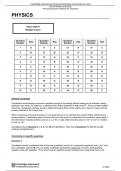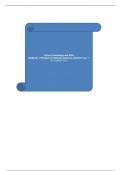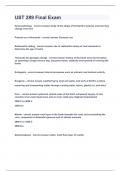Cambridge International Advanced Subsidiary and Advanced Level 9702 Physics June 2022 Principal Examiner Report for Teachers © 2022 PHYSICS Paper 9702/11 Multiple Choice Question Numbe r Key Question Numbe r Key Question Numbe r Key Question Numbe r Key 1 D 11 C 21 A 31 C 2 B 12 B 22 D 32 B 3 A 13 A 23 C 33 D 4 C 14 B 24 D 34 D 5 C 15 A 25 A 35 D 6 C 16 A 26 B 36 A 7 D 17 C 27 B 37 D 8 D 18 A 28 A 38 D 9 B 19 A 29 B 39 C 10 D 20 D 30 D 40 C General comments Candidates should always read each question through in its entirety before looking at the answers, taking particular care when, for instance, a question asks ‘which statement is not correct?’. All four answer options should be considered carefully, trying to justify eliminating three of the options as a check to make sure the answer selected is the correct one. When answering numerical questions, it is a good idea to try to calculate the answer before looking at the answer options. Candidates need to ensure that the units used in a calculation are consistent, particularly if the information includes prefixes such as k, μ or M, or data which includes areas in mm
2 or cm2 or volumes in mm3 or cm3. Candidates found Questions 1, 6, 9, 13, 30 and 34 difficult. They found Questions 11, 20 , 21 and 26 relatively straightforward. Comments on specific questions Question 1 Candidates should understand that all physical quantit ies consist of a numerical magnitude and a unit. Very few candidates selected B or C, but many candidates selected A suggesting confusion distinguishing between units and quantities. The correct answer was D as spring constant has a magnitude and a unit. Cambridge International Advanced Subsidiary and Advanced Level 9702 Physics June 2022 Principal Examiner Report for Teachers © 2022 Question 6 Candidates seemed to find this question difficult, and ans wers were evenly distributed over all four choices. With negligible air resistance, the horizontal component of velocity vH will remain constant at 10.0 m s–1 but the vertical component of velocity vV will increase as the ball experiences free fall acceleration. Substituting the data into vV = u + at gives vV = 29 m s–1. Pythagoras’ theorem can then be used to determine the speed of the ball at the instant before it hits the ground, i.e. 31 m s–1, which is C. Candidates who added the vertical and horizontal components of velocity together withou t considering their perpendicular directions obtained incorrect answer D. Question 9 As with Question 6 , for questions involving projectile motion, the challenges for candidates are in handling several pieces of information and there being more than one step to calculate the final answer. Many candidates appreciated that the projectile expe riences weight acting vertically downwards, but many candidates held the common misconception that objects require a force in the direction of motion. Almost half of all candidates incorrectly chose A. The projectile is travelling through air, and air resistance is not described as negligib le. At position X the instantaneous motion of the projectile is horizontally to the right, so air re sistance must act to the left. This means that B is correct. Question 13 This question required an understanding of the conditions for a system to be in equilibrium. The rod at P and the person at R both exert downwa rd forces on the board, and the rod at Q exerts an upward force. The board is trying to pivot about point Q. As the person moves fr om R to Q, the downward force exerted by the person does not change. As the perpendicular distance between the person and point Q decreases, the clockwise moment about Q decreases. Consequently, the anticlockw ise moment and the force at P must also decrease. Since the total downward force has decreased, so the upwar d force at Q must also decrease, and A is correct. Question 19 The lengths of the wires are related by LQ = ½LP and, because the diameter is doubled, the cross-sectional areas are AQ = 4AP. Both wires experience the same force F, and being made of the same material they have the same Young modulus E. E = stress / strain = ( F / A) / (x / L) and so extension x = FL / AE. The ratio of the extensions is then given by: xP / xQ = (LP / AP) / (LQ / AQ) = (LP / AP) / (½ LP / 4AP) = 8 (answer A). A common incorrect answer was B. Candidates who did not square the factor of 2 in the diameter would have concluded that AQ = 2AP, and arrived at B. Cambridge International Advanced Subsidiary and Advanced Level 9702 Physics June 2022 Principal Examiner Report for Teachers © 2022 Question 22 This question proved challenging. Many candidates chose the incorrect answer C. Constant frequency means that the time period is unchanged, so A and B can be ruled out. Using intensity ∝ (amplitude )2, candidates needed to take the square root of the ratio of intensities to find the ratio of amplitudes: 10.712= (to 2 significant figures), so D is correct. Answer C arises from erroneously thinking that halving the intens ity simply halves the amplitude. Question 28 More candidates chose the incorrect answer B than the correct answer A. Candidates should be able to show an understanding of experiments that demonstrate diffraction including the qualitative effect of the gap width relative to the wavelength of the wave. For a ga p that is much wider than the wavelength of the wave, the spreading of the wave – and hence the diffraction angle – is less than for a smaller gap. The wavelength is unaffected. Question 30 For light that has passed through the diffraction gr ating, the maximum diffraction angle for dots appearing on the semicircular screen is 90°, measured from the straight through (zero-order) position: nλ = d sin θ n = (2.0 × 10–6 × sin 90°) / 5.4 × 10–7 = 3.7. The order number must be an integer, so the maximum order number for viewable bright dots on the screen is 3 – this would suggest A for candidates who took their deduction s no further. Candidates who recognised that there is also a zero-order dot may have thou ght that the answer is: 3 + 1 = 4, whereas those who recognised that the pattern is symmetrical on the scre en but forgot about the zero order will have doubled 3 to incorrectly arrive at C. The correct answer is D: 3 + 1 + 3 = 7 bright dots. Question 33 More candidates selected A than the correct answer D. Candidates should appreciate that re sistance is calculated by dividing a specific value of potential difference by the corresponding value of current. It is not determined from the gradient of the current–voltage characteristic. Considering R = V / I it is apparent that D is correct. Above the threshold voltage for the diode, the cu rrent–voltage characteristic becomes very steep and approximately linear. Candidates who mistakenly believed that a linear relationship is the same as direct proportionality may have thought that the diode behaves as an ohmic conductor for values of p.d. above the threshold voltage. Cambridge International Advanced Subsidiary and Advanced Level 9702 Physics June 2022 Principal Examiner Report for Teachers © 2022 Question 34 This question was found to be very difficult, with many candidates selecting the incorrect answer C. The wires are made from the same material, so they have the same resistivity and the same density. The wires must also have the same volume since they have the same mass. For wire 1: R1 = ρL / A For wire 2: 2113/ RL A L A R ρρ== = For C to be most popular answer, the majority of the cand idates correctly identified the factor of three in relation to the length but did not realise the effect on the cross-sectional area and consequently on the resistance.






